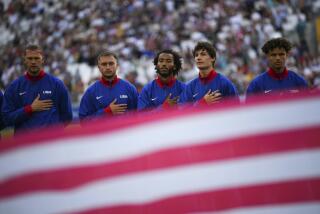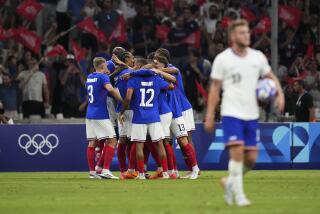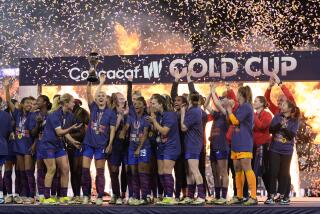No Lights, Camera, Just Soccer Action
- Share via
Barry Manilow will not be in Marseille today, a fact for which France can be forever grateful. Nor, thank goodness, will James Brown.
In fact, unlike four years ago, when soccer was more or less a sideshow to the main event in Las Vegas, today’s draw for the 1998 World Cup will put the sport first and show business a distant second.
Certainly, there was a laser light show over the 2,600-year-old city’s Old Harbor on Wednesday night. And certainly FIFA’s president, Joao Havelange of Brazil, was still creating havoc by again rejecting even a supporting role for his compatriot, Sir Edson Arantes do Nasciemento.
But even barring the newly knighted Pele from an active role in the proceedings at the Stade Velodrome is not enough to dampen the sense of excitement and anticipation surrounding today’s draw.
After two years’ of qualifying play narrowed 172 nations to the 32 that will make up the France ’98 field next summer, the world will find out who plays whom, where and when.
Will the United States be drawn in the same group as world champion Brazil? Will England and Germany again have to square off as they did in Italy ’90 and Euro ‘96? How will World Cup newcomers Croatia, Jamaica, Japan and South Africa fare?
Those questions and others will be asked by fans glued to television sets worldwide and at Olympique Marseille’s sold-out stadium. The draw and its accompanying game will be shown live on ESPN2 at 7:30 a.m. PST.
Staging the draw in a soccer stadium and preceding it with a Europe vs. the Rest of the World all-star game demonstrates a desire to tie this event more closely to the sport. The razzmatazz of Las Vegas, where Manilow and Brown were among those trotted out on stage, has been replaced by the roar of a real soccer crowd.
Today’s game features players from each of the 32 World Cup competitors. The result is unimportant. What matters is what follows, which is basically a lottery, but with some rules.
The draw will divide the 32 qualified countries into eight groups of four for first-round play, starting June 10 in Paris. In very real terms, the draw decides each team’s fate before it steps on the field.
“I remember very vividly ‘93, when we went into the draw and said the one team we didn’t want to get drawn into our group was Colombia,” said Alan Rothenberg, president of U.S. Soccer. “And lo and behold, we got Colombia. It turned out that was the most fortuitous draw because, if we hadn’t beaten Colombia, we wouldn’t have gone through to the second round.
“I don’t have a dream draw. What I have is a dream result. And that is to get out of the first round and proceed from there. We aren’t going to do it unless we beat good teams.”
Before leaving for France with the rest of the U.S. delegation on Tuesday, U.S. Coach Steve Sampson was asked for best- and worst-case scenarios. He chose not to tackle the query.
Rothenberg and Sampson are looking at France ’98 in a more or less realistic way, although their rose-colored glasses are still close at hand.
“I’ve said all along that I felt this is a team that can get to the second round,” Sampson said, “but equally important is how well we play. We have a lot more experience [than in 1994]. We understand what it means to play in front of big crowds and in big events, and we will have the confidence to play against anybody that we confront in our group.
“I think we can get to the second round, and it’s very important that we do.”
FIFA will provide each team with $535,000 to prepare for the tournament and $714,000 for each game it plays.
(BEGIN TEXT OF INFOBOX / INFOGRAPHIC)
World Cup Events
* What: FIFA All-Star game and World Cup ’98 draw.
* Where: Stade Velodrome, Marseille, France.
* The game: Europe vs. Rest of the World.
* The draw: The 32 countries that have qualified for the June 10-July 12 tournament will be divided into eight groups of four for first-round play. Only the winners and runners-up advance.
* TV: ESPN2 at 7:30 a.m. PST. Repeated at 4:30 p.m.






